If you're shopping for a sub-$45k three-row family hauler, nearly all of your options (aside from the largest SUVs) are now car-based with transverse, front-wheel-drive-based powertrains. One of the last holdouts, the Nissan Pathfinder, made the switch from a truck to a car platform last year. But the Dodge Durango remains essentially a Jeep Grand Cherokee with a longer wheelbase (119.8 vs. 114.8 inches) and overall length (201.2 vs. 189.8 inches) to fit a third-row seat. Does this conventional SUV basis give the Durango some clear advantages? Should you get one while you still can? What about the disadvantages that have led nearly everyone else to abandon this vehicle type?
Enhancements to the Dodge Durango for 2014 include new instruments, a new infotainment interface, and an eight-speed automatic transmission. I specifically requested the 290-horsepower, 3.6-liter V6 rather than the 360-horsepower, 5.7-liter V8 to see if the new transmission renders the larger engine less necessary.
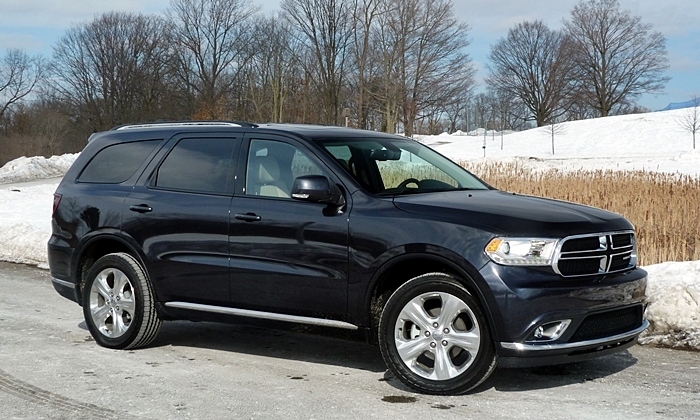
Are such clean, fluid lines dated or timelessly tasteful? more Durango photos
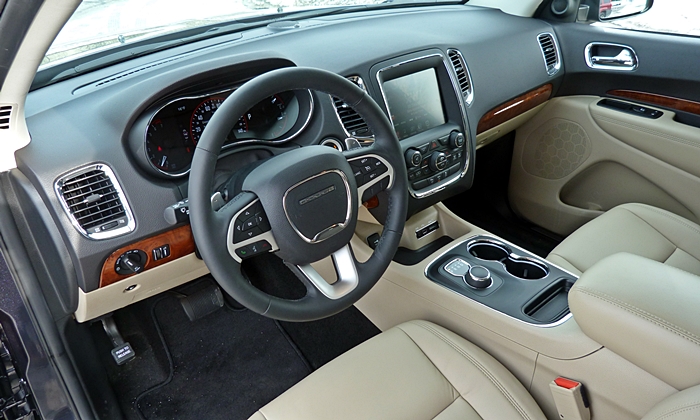
Like the exterior, the interior's styling is clean, perhaps to a fault.
| |
Compared to the Pathfinder |
| Handling |
 Better
Worse
Better
Worse
|
The Durango doesn't drive like a sports car, or even a sport sedan. It's too tall and too heavy to inspire such an analogy. Also, the Dodge SUV's steering is light and provides little feedback. But its longitudinal powertrain contributes to a nearly balanced weight distribution (car-based competitors are all nose-heavy). This plus a well-tuned all-independent suspension and solid body structure contribute to a balanced, poised feel through turns that you won't find in any other three-row SUV without a pricey European badge.
Even the far more expensive (and distantly related) Mercedes-Benz GL-Class doesn't handle as well, largely thanks to a stability control system that cuts in too early and too aggressively. The Durango's system is much less obtrusive. An Audi Q7 poses stiffer dynamic competition, but like the Mercedes costs far more than the Dodge. GM's and Ford's conventional SUVs are much wider, taller, and heavier, and don't feel nearly as athletic. The Toyota 4Runner is much closer in price to the Dodge but, partly because it is tuned more for off-road driving, it's not nearly as athletic in on-road driving (for which Toyota offers the car-based Highlander).
For fecund driving enthusiasts seeking to maximize handling, Dodge offers the Durango in R/T form. But the R/T's firmer steering and suspension don't make a dramatic difference, at least not with all-wheel-drive. (A brief drive a few years ago in a rear-wheel-drive Durango discovered more potential for entertaining handling.) While surprisingly pleasant to drive, the Durango R/T AWD doesn't beg to hammered along a twisty road much more than the tested Limited. It's just not that kind of vehicle.
| Towing |
 Better
Worse
Better
Worse
|
Most current three-row car-based crossovers, including the Nissan Pathfinder, are rated to tow 5,000 pounds, impressive for vehicles with transverse powertrains (and thus compact transmissions, a CVT in the case of the Nissan). Oddly, Toyota rates the truck-based, body-on-frame 4Runner for a little less, 4,700 pounds.
Even with its standard V6 the Durango is rated to tow significantly more, 6,200 pounds. Step up to the V8, and the tow rating climbs to 7,400 pounds with rear-wheel drive, 7,200 pounds with all-wheel drive. Beyond these figures, I'd feel far more confident towing a heavy load with the Durango's heavier duty, longitudinal transmission. Standard anti-sway control, which selectively applies the brakes to counteract any swaying induced by a trailer, adds to the Dodge's towing advantages.
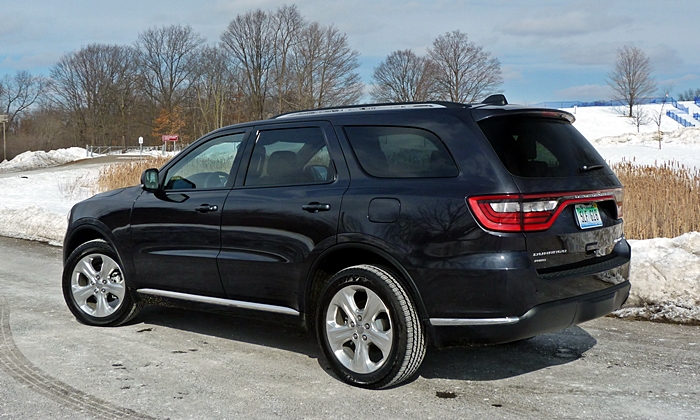
Longer tail than on the foot-shorter Jeep to fit the third-row seat.
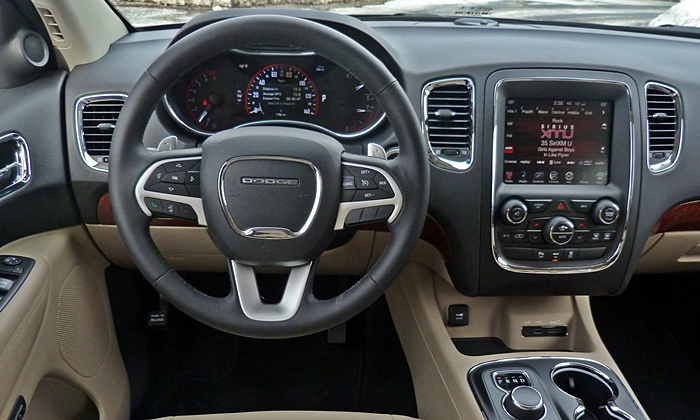
Controls are among the best for usability, but electronics have been buggy and knobs feel cheap.
| Controls and instruments |
 Better
Worse
Better
Worse
|
Just about every auto maker has been fumbling around with innovative control interfaces. Among touchscreen-based systems, Chrysler's latest--added to the Durango for 2014--is by far the easiest to use, with large, well-spaced, logically organized buttons and lightning-quick responses. Redundant conventional controls include three large knobs, which is three more than you'll find with many of the latest systems.
As in other recent Chrysler products, the instruments place a somewhat reconfigurable LCD between a couple of analog gauges styled to make them appear part of the LCD at a glance. These instruments appear more impressive in a $20,000 Dart than in a $40,000+ Durango. Functionally, though, they perform well.
| Rear seat room & comfort |
 Better
Worse
Better
Worse
|
The Durango's relatively narrow width, a plus for handling, has the opposite impact on interior room. These are very much two sides of the same coin. Because the Durango's cabin isn't terribly wide it feels more agile than wider SUVs. But three passengers in the second row don't have as much space to spread out--those in a Nissan Pathfinder enjoy a couple more inches of shoulder room--and only two people can sit in the third row. (The Honda Pilot, Toyota Highlander, and GM's large crossovers all have three belts back there.) Leg room in the Durango is much more competitive, but still a few inches short of class leading.
This said, comfort isn't only a matter of interior dimensions. Both of the Durango's rear rows are well-upholstered and positioned higher off the floor than the three-row crossover norm. This benefits both thigh support and outward visibility. The Hyundai Santa Fe isn't far off in this regard, but the Nissan Pathfinder's seats are much closer to the floor, and less hospitable to adults as a result. Among the three, I'd prefer to be a rear seat passenger in the Dodge. Among large conventional SUVs, the Ford Expedition has a more comfortable third row, but the Chevrolet Tahoe (which retains a live rear axle despite a comprehensive redesign for the 2015 model year) doesn't come close. And the foot-shorter 4Runner? Its XXS third-row seat is best saved for emergencies.
On the other side of the ledger, the Durango does have a higher floor than the typical car-based crossover. Getting in and out isn't as easy. This vies with curb weight as the top disadvantage of the Durango's conventional SUV configuration.
| Exterior styling |
 Better
Worse
Better
Worse
|
You won't find better proportions or cleaner styling in a three-row crossover or SUV. Unlike with an increasing number of competitors, the Durango's face won't cause children to have nightmares.
Yet I hesistate to list exterior styling among the reasons to buy a Dodge Durango because its lines are so clean they border on generic and so fluid they appear a little dated next to competitors' edgier sheetmetal. The long-gone second-generation Oldsmobile Bravada, with a similar appearance, was introduced as a 2002 model.
Ultimately, this one's a matter of personal taste.
The interior benefits and suffers from the same minimalism. Clean lines, but some areas, especially the black trim plate around the shift knob, appear overly plain.
| |
Compared to the Pathfinder |
| Reliability & durability |
 Better
Worse
Better
Worse
|
We don't yet have enough reliability data for the Dodge Durango, but the refreshed, closely related Jeep Grand Cherokee hasn't been faring well. Blame the new infotainment system, bugs in which apparently can affect everything in the instrument panel. In the tested vehicle, both the audio system and the climate control often behaved oddly. Most likely Chrysler will develop a thorough fix soon. But until then, glitches are likely.
Two optional features that were problematic in recent years with the Grand Cherokee, an air suspension and a panoramic sunroof, aren't offered on the Durango.
This said, both the Nissan Pathfinder and the Hyundai Sante Fe also required an above average number of repairs in their first model year. Early glitches aren't unique to Dodge.
| Driving position & visibility |
 Better
Worse
Better
Worse
|
In traffic the Dodge Durango provides the outward visibility that won people over to SUVs in the first place. You sit higher than in most other vehicles and, unlike in the Pathfinder and the Santa Fe, the instrument panel doesn't extend halfway to the nose. Visibility to the rear is limited by the height of the rear window's lower edge, but this is typical of SUVs.
Not quite as typical: nose into a parking space and it's nerve-wrackingly difficult to tell where the front corners are. Forward obstacle detection or around-view cameras would help. The latter are standard on the top-of-the-line Pathfinder, while the Santa Fe feels significantly more compact (partly because it is). Rear-obstacle detection and a rearview camera are optional on the base Durango, standard on the other trim levels.
One unusual aid to visibility: a button on the Dodge's instrument panel flops the third-row headrests forward. This can also help rein in unruly third-row passengers.
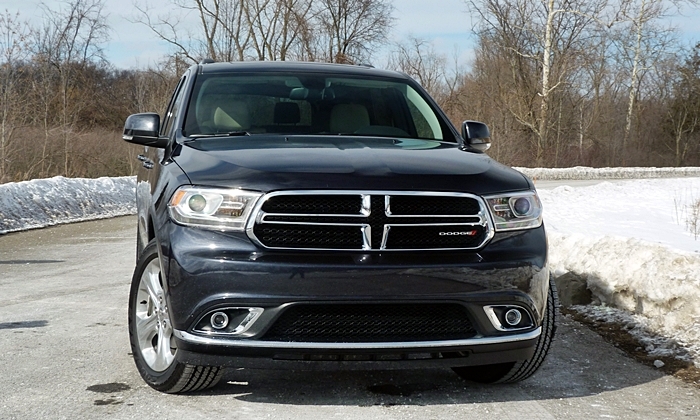
Cleaner, less menacing face than most these days.
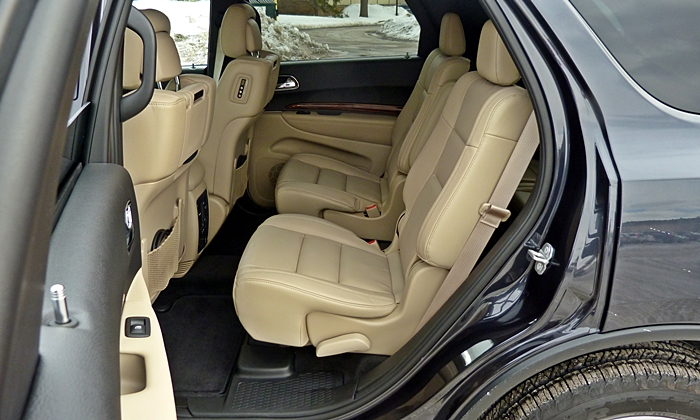
Second row isn't the widest, but is high and comfortable. Bench standard, these captains optional.
| Ride smoothness |
 Better
Worse
Better
Worse
|
With a long wheelbase and a well-tuned independent suspension at all corners, the Durango rides more smoothly than the typical conventional SUV, and feels nearly as solid as Europe's best. This suspension deals especially well with major disturbances in the road surface. Add in class-leading quietness, and your ears and gut will sense an upscale vehicle. For this reason you'll often find ride quality listed among the Durango's strengths elsewhere.
But the dirty little not-so-secret of conventional SUVs is that even the best-suspended ones don't ride like cars. The Durango's optional 265/50R20 tires feel massive as they work their way over small bumps and chuckholes. No harshness, just a mild jostle here and there along with the inescapable sensation of a lot of mass in play. This sensation was even more evident in the more firmly suspended Mercedes-Benz GL350 BlueTEC. But some car-based crossovers, including the Nissan Pathfinder, better absorb small bumps and toss their occupants side-to-side less when traversing wavy road surfaces.
| Fuel economy |
 Better
Worse
Better
Worse
|
The new-for-2014 eight-speed automatic does its best to wring competitive fuel economy out of the 3.6-liter V6, but the Durango AWD's curb weight, at 5,000 pounds about 600 more than the Pathfinder's, poses an apparently insurmountable handicap. The 2014 Dodge's EPA ratings of 17 mpg city, 24 mpg highway are higher than the 2013's, but only by a single mpg. The Pathfinder, with its lower curb weight and efficiency-boosting continuously variable transmission (CVT), manages 19/25.
In my real-world testing the Nissan's advantage seemed at least as large as the EPA ratings suggest. In the suburbs the Dodge's trip computer usually reported averages in the high teens, while the Nissan's reported averages in the low-to-mid 20s. The best suburban average I observed in the Durango was not quite 21, compared to the Nissan's 26. In the Dodge's defense, I tested it in unusually cold weather, so the apples-to-apples difference might be closer to the 12 percent suggested by the EPA city ratings.
The Nissan's CVT isn't nearly as much an advantage and the Dodge's extra pounds aren't as much a disadvantage in highway cruising, so I'm not surprised that their EPA highway numbers are closer.
It's worth nothing that, while it can't match the Pathfinder, the Durango V6's ratings are much better than the 14/22 of the optional "Hemi" V8. You won't find better numbers in a conventional SUV of this size without the assistance of a diesel engine (offered in the Jeep).
| Feature availability |
 Better
Worse
Better
Worse
|
As noted above, you can't get an around-view camera system or forward obstacle detection on the Durango. Nor can you get the diesel engine, air suspension, advanced off-roading features, or panoramic sunroof that are optional with the related Jeep Grand Cherokee. You can get an around-view camera system and glass over the second row in the Nissan Pathfinder, and a panoramic sunroof in the Hyundai Santa Fe.
| |
Compared to the Pathfinder |
| Materials & workmanship |
 Better
Worse
Better
Worse
|
Depending on which parts of the vehicle you examine, the materials and workmanship of the Dodge Durango can be either a pro or a con. As already noted, the Durango sounds and feels like an upscale vehicle costing far more than it does. The body structure oozes solidity, body motions feel polished (even high-priced SUVs suffer from the ride shortcomings noted earlier), and noise levels are low. Interior surfaces are mostly soft to the touch (in sharp constrast to the hard plastic instrument panel in the Pathfinder), and also feel solid. While the Limited's leather seats are at least as good as the average hides in this price range, those who desire luxuriously soft leather should spend a little extra for the Citadel.
Unfortunately, the knobs and buttons, though highly ergonomic, don't do their part to maintain this upscale impression. Nearly all of them feel insubstantial, like the parts in cheap toys. As does the rotary knob that serves as a shifter. I had hoped that the revisions for 2014 would include higher grade switchbear, but they didn't.
| Powertrain performance |
 Better
Worse
Better
Worse
|
When paired with a Mercedes-supplied five-speed automatic, Chrysler's 290-horsepower 3.6-liter V6 wasn't up to the task of motivating 5,000 pounds of curb weight. So I recommended the optional V8 with the 2011 to 2013 Durango. With the 2014's eight-speed automatic, though, the V6 feels plenty strong in typical driving, and competitive with lighter V6-powered competitors. During a week with the revised Dodge I never wished for more power. This year, the 360-horsepower "Hemi" 5.7-liter V8 doesn't feel much quicker, though it does make more noise (music to an enthusiast's ears) and suck more fuel in the process (music to OPEC's ears). As mentioned earlier, this simply isn't the sort of vehicle in which you're likely to require more thrust than the V6-plus-eight-speed can deliver. So with the 2014 Durango I recommend the V6 except for heavy towing or off-roading (a two-speed transfer case is only available with the Hemi).
| Front seat support & comfort |
 Better
Worse
Better
Worse
|
The Durango's moderately firm front seats are comfortable, but could use a little more contour. I had a similar impression of the Pathfinder's front seats. The Dodge's do offer four-way adjustable lumbar, compared to the Nissan's two-way, but I still struggled to fit the bulge to my particular back.
| Cargo capacity |
 Better
Worse
Better
Worse
|
Conventional SUVs aren't as space efficient as car-based crossovers, and the Durango, while a few inches longer than the Pathfinder, only contains a bit more cargo volume. Neither has enough space for more than a few pieces of luggage behind their third-row seats. GM's and Ford's large crossovers and any given minivan will serve better in this regard.
The Durango has an ace up its sleeve, though. Unless you opt for upgraded leather (standard on the Citadel, optional on the R/T) or the rear seat entertainment system, the front passenger seat can fold forward to extend the cargo area all the way to the instrument panel. So if you need to carry some especially long objects inside the vehicle, the Durango has an edge over every other crossover and SUV save the Ford Flex.
| Price or payments |
 Better
Worse
Better
Worse
|
As might be expected given its upscale qualities and state-of-the-art powertrain, the Dodge Durango isn't inexpensive. The base model starts at $30,790. A loaded Citadel with the $2,795 V8 lists for $53,365. Opt for the mid-level Limited, add AWD, a $2,395 Premium Group (polished 20-inch wheels, nav, high-watt audio system, sunroof, power liftgate), $1,995 dual screen rear seat entertainment system, and $995 towing package, and you get $44,775 at the bottom of the window sticker.
The tested car further included a $1,195 Safety / Security and Convenience Group (xenon auto-dimming headlights, rain-sensing wipers, power tilt-and-telescope steering wheel, blind spot monitor, cargo cover) and $895 captain's chairs. But we're going to ignore these features and their impact on the bottom line because you can't get them on the Pathfinder.
Configure a Nissan Pathfinder Platinum like that $44,775 Durango, and its list price comes to an almost identical $44,560. Adjust for remaining feature differences, and the Dodge undercuts the Nissan by about $1,500. This advantage goes away if you compare invoice prices, though. Nissan dealers enjoy larger margins, so they can potentially add a larger discount to any available factory incentives. All in all, the Durango and Pathfinder are priced pretty close to one another.
A Hyundai Santa Fe is about $2,600 less than the Durango, but it's also smaller. On the other hand, a Toyota 4Runner is about $1,700 more than the Durango, but it's much less lengthy and its optional third row is very tight. Other three-row conventional SUVs, especially those from the premium German makes, are all far more expensive than the Dodge.
The 2014 Dodge Durango offers the polished handling and solid, refined feel of premium European SUVs, at a much lower (if still far from low) price. With the new eight-speed automatic transmission, its V6 delivers competitive (if short of class-leading) performance and fuel economy. And rear seat comfort is up with the segment's best. Though the Durango's ride retains hints of truck, overall it benefits much more than it suffers from its conventional underpinnings.
The main reasons not to buy a Durango have nothing to do with these underpinnings. Chrysler has some bugs to sort out in the new infotainment system. And it should try to add either forward-obstacle detection or an around-view camera system, ideally both. Without these, Durango drivers will often fear trading paint in parking lots.
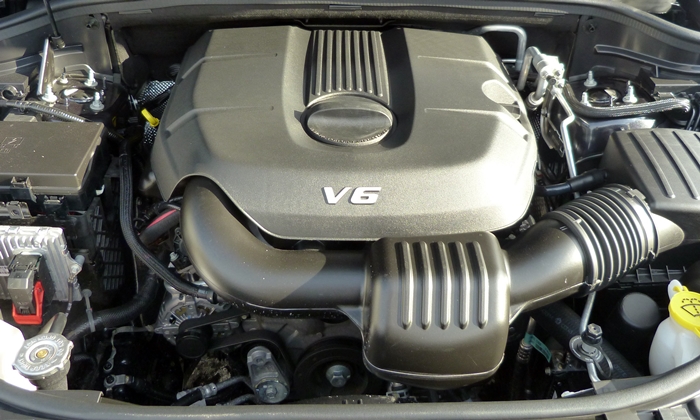
V6 engine much more competitive when paired with the new eight-speed automatic.
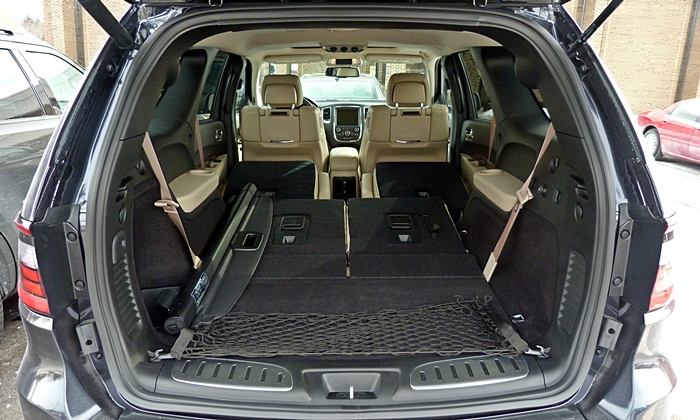
Don't order premium leather or the entertainment system, and front passenger seat would also fold.
See more 2014 Dodge Durango photos
Dodge and Nissan each provided an insured vehicle for a week with a tank of gas.











